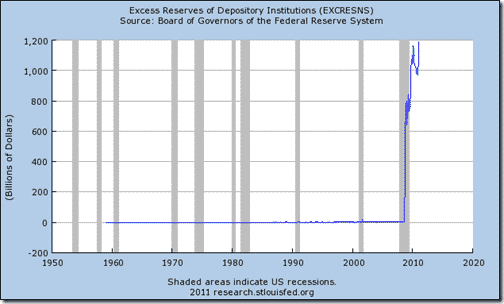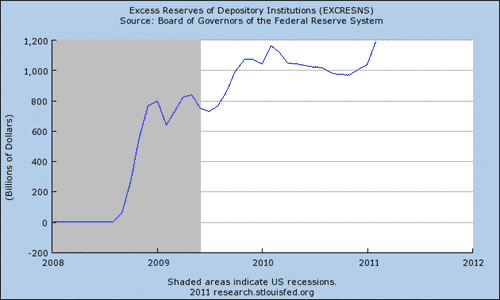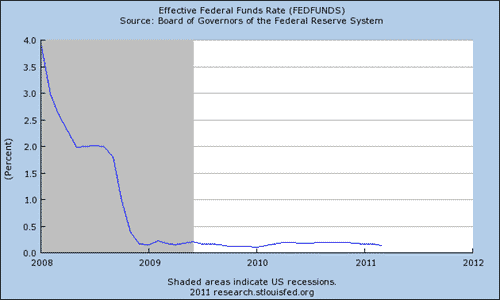Chart of the Day: Excess Reserves
Since the financial crisis hit in 2008, excess reserves have piled up in the U.S. financial system. There were almost no excess reserves in the system during the period of recorded data from 1959 onwards. But after the post-Lehman Brothers panic and the Fed’s zero interest rate policy, reserves piled up.
The build up of excess reserves has coincided with a steep fall in the money multiplier.
In a fiat money system, there is not a very good correlation between base money and M1 and credit because reserves don’t create loans. In practice, the lending operations of commercial banks have no interaction with reserve operations. Lenders simply take applications from customers who seek loans and assess creditworthiness and lend accordingly.
In approving a loan, banks instantly create a deposit, a zero net financial asset transaction – and this happens entirely independently of the reserve requirement. In Australia, Canada, Sweden and New Zealand there are no bank reserve requirements. In periods when credit is expanding, if a banking system is at the reserve requirement limit, the central bank can either:
- create new reserves;
- relax the reserve ratio; or
- refuse to create new reserves and cause a credit crunch
In practice, central banks have opted to create new reserves, which is accomplished by buying financial assets with newly created money (in the form of electronic credits on bank balance sheets).
Right now, credit growth is anaemic because of either a lack of demand by creditworthy borrowers or a fear of capital constraints at lenders. Anecdotally, both issues seem to be at play. That has meant that the Fed’s injection of reserves into the system has led to a pile up of excess reserves instead of new lending.
I have been saying QE2 will end as planned and that the Fed will pause to assess the economy before doing anything else. Based on Federal Reserve messaging, QE2 does look to be winding down on schedule. If economic growth in the U.S. does not falter in the second half of 2011, the Fed will look to drain excess reserves from the system as preparation for an interest rate hike at some unforeseeable future date.



Reserve requirements are no longer binding — increasing levels of vault cash (larger ATM networks), retail deposit sweep programs, fewer applicable deposit classifications, & lower reserve ratios, have combined to remove most reserve, & reserve ratio, restrictions.
The member banks are unencumbered in their lending operations (except for bank capital adequacy ratios, credit worthy customers, & high quality investments).
“banks instantly create a deposit, a zero net financial asset transaction – and this happens entirely independently of the reserve requirement”
The effect of tying open market policy to any policy rate target, is to supply additional (and excessive Federal Reserve Bank credit) to the banking system when loan demand increases. This is the process by which the FED financed the rampant real-estate speculation.
Reserve requirements are no longer binding — increasing levels of vault cash (larger ATM networks), retail deposit sweep programs, fewer applicable deposit classifications, & lower reserve ratios, have combined to remove most reserve, & reserve ratio, restrictions.
The member banks are unencumbered in their lending operations (except for bank capital adequacy ratios, credit worthy customers, & high quality investments).
“banks instantly create a deposit, a zero net financial asset transaction – and this happens entirely independently of the reserve requirement”
The effect of tying open market policy to any policy rate target, is to supply additional (and excessive Federal Reserve Bank credit) to the banking system when loan demand increases. This is the process by which the FED financed the rampant real-estate speculation.
The source of IORs is not homogeneous: System Open Market Account (SOMA), holdings: agency debt, mortgage-backed securities, & Treasury’s ($1.7t – QE1), & Treasury securities ($.6t – QE2), were acquired thru open market operations of the buying type (via monetization between the Reserve Banks & the Commercial Banks, i.e., by simultaneously crediting member bank balances).
However, in the longer time frame, an indeterminate proportion might be attracted and absorbed (depending upon the remuneration rate), from the existing money supply (i.e., bank deposits/savings).
Contrariwise, allowing excess reserves to run-off (or be drained by open market operations of the selling type, term-deposits, reverse repos, etc.), either reintroduces these loan-funds into the banking system (or destroys them).
Ongoing, the banker’s decision to retain idle deposits at the District Reserve Banks is dependent upon competitive financial instruments & returns in the domestic markets (vis-à-vis the remuneration rate).
Thus, for example, if the BOG’s monetary policy sets the target FFR rate, higher than the remuneration rate, excess reserves will decline – ceteris paribus (& vice versa).
The initial beneficial effects of the FED’s asset swap will eventually be washed out.
If IORs are indeed an operational “floor”, then IORs induce dis-intermediation among the non-banks – thereby decreasing the supply, & increasing the cost, of loan-funds (in and of themselves). And what was taken off the Treasury market was to some degree offset by the outstanding supply of competing instruments & yields under the short-end of the yield curve.
For example, prior to the FDIC’s rule change (Friday’s implementation of the Dodd-Frank legislation), “institutions with the ability to deposit cash at the Federal Reserve, the IOER level was a boon. These institutions borrowed cash, in say, repo or fed funds, and deposit the proceeds at the Fed to earn the spread.”
Relative to the remuneration rate, increasing interest rates are supposed to incent lending & investing, and decreasing rates should absorb loan-funds. But where did Bill Gross park his money in the anticipation of higher Treasury rates (not in mortgage backed securities)?
And if the economy slows (with no change in the existing peg), monetary policy becomes reinforcing (i.e., the yield curve’s IOR maturity lengthens – or shortens), exaggerating the economic pendulum.
IORs, the FED’s OMO offset for SOMA holdings – regardless of the type of asset purchase (unlike raising reserve ratios), reduce money velocity.
I.e., IORs are not just a contractionary open market device for conducting monetary policy within the CB banking system, they exert a profoundly deflationary force (a cessation of the circuit income & transactions velocity of funds), in our highly interdependent pecuniary economy.
How so? Because coming out of a recession, IORs have only one operational exit path – i.e., via higher interest rates in the loan-fund markets.
The source of IORs is not homogeneous: System Open Market Account (SOMA), holdings: agency debt, mortgage-backed securities, & Treasury’s ($1.7t – QE1), & Treasury securities ($.6t – QE2), were acquired thru open market operations of the buying type (via monetization between the Reserve Banks & the Commercial Banks, i.e., by simultaneously crediting member bank balances).
However, in the longer time frame, an indeterminate proportion might be attracted and absorbed (depending upon the remuneration rate), from the existing money supply (i.e., bank deposits/savings).
Contrariwise, allowing excess reserves to run-off (or be drained by open market operations of the selling type, term-deposits, reverse repos, etc.), either reintroduces these loan-funds into the banking system (or destroys them).
Ongoing, the banker’s decision to retain idle deposits at the District Reserve Banks is dependent upon competitive financial instruments & returns in the domestic markets (vis-à-vis the remuneration rate).
Thus, for example, if the BOG’s monetary policy sets the target FFR rate, higher than the remuneration rate, excess reserves will decline – ceteris paribus (& vice versa).
The initial beneficial effects of the FED’s asset swap will eventually be washed out.
If IORs are indeed an operational “floor”, then IORs induce dis-intermediation among the non-banks – thereby decreasing the supply, & increasing the cost, of loan-funds (in and of themselves). And what was taken off the Treasury market was to some degree offset by the outstanding supply of competing instruments & yields under the short-end of the yield curve.
For example, prior to the FDIC’s rule change (Friday’s implementation of the Dodd-Frank legislation), “institutions with the ability to deposit cash at the Federal Reserve, the IOER level was a boon. These institutions borrowed cash, in say, repo or fed funds, and deposit the proceeds at the Fed to earn the spread.”
Relative to the remuneration rate, increasing interest rates are supposed to incent lending & investing, and decreasing rates should absorb loan-funds. But where did Bill Gross park his money in the anticipation of higher Treasury rates (not in mortgage backed securities)?
And if the economy slows (with no change in the existing peg), monetary policy becomes reinforcing (i.e., the yield curve’s IOR maturity lengthens – or shortens), exaggerating the economic pendulum.
IORs, the FED’s OMO offset for SOMA holdings – regardless of the type of asset purchase (unlike raising reserve ratios), reduce money velocity.
I.e., IORs are not just a contractionary open market device for conducting monetary policy within the CB banking system, they exert a profoundly deflationary force (a cessation of the circuit income & transactions velocity of funds), in our highly interdependent pecuniary economy.
How so? Because coming out of a recession, IORs have only one operational exit path – i.e., via higher interest rates in the loan-fund markets.